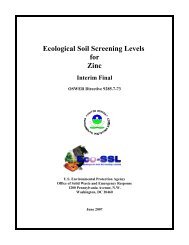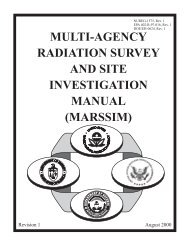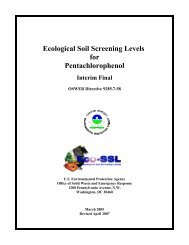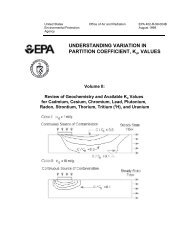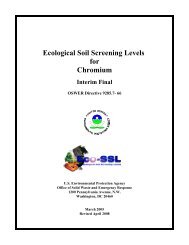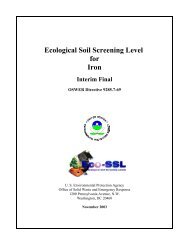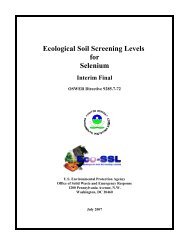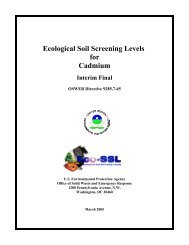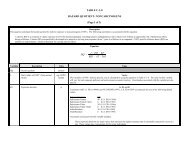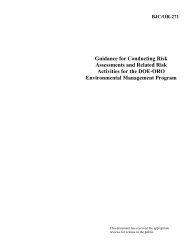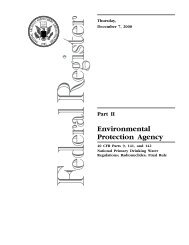Nickel - The Risk Assessment Information System
Nickel - The Risk Assessment Information System
Nickel - The Risk Assessment Information System
Create successful ePaper yourself
Turn your PDF publications into a flip-book with our unique Google optimized e-Paper software.
Within the reviewed papers there are 119 results for biochemical (BIO), behavior (BEH),<br />
physiology (PHY), pathology (PTH), reproduction (REP), growth (GRO), and survival (MOR)<br />
endpoints with a total Data Evaluation Score >65 that were used to derive the TRV (U.S. EPA<br />
2003; Attachment 4-4). <strong>The</strong>se data are plotted in Figure 6.1 and correspond directly with the data<br />
presented in Table 6.1. <strong>The</strong> NOAEL results for growth and reproduction are used to calculate a<br />
geometric mean NOAEL. This geometric mean is examined in relationship to the lowest bounded<br />
LOAEL for reproduction, growth, and survival to derive the TRV according to the Eco-SSL<br />
guidance (U.S. EPA 2003; Attachment 4-5).<br />
A geometric mean of the NOAEL values for reproduction and growth was calculated at 7.70 mg<br />
nickel/kg bw/day. However this value is higher than the lowest bounded LOAEL for<br />
reproduction, growth, or mortality results. <strong>The</strong>refore, the TRV is equal to the highest bounded<br />
NOAEL below the lowest bounded LOAEL for reproduction, growth, or survival, and is equal to<br />
1.70 mg nickel/kg bw/day.<br />
6.2 Estimation of Dose and Calculation of the Eco-SSL<br />
Two separate Eco-SSL values were calculated for mammalian wildlife, one for each of two<br />
surrogate receptor groups representing different trophic levels. <strong>The</strong> mammalian Eco-SSLs<br />
derived for nickel were calculated according to the Eco-SSL guidance (U.S. EPA, 2003;<br />
Attachment 4-5) and are summarized in Table 6.2. An Eco-SSL value could not be calculated for<br />
the mammalian ground insectivore (shrew) as a reliable method to estimate uptake of nickel from<br />
soil into soil invertebrates could not be identified (see Attachment 4-1 of the Eco-SSL guidance<br />
(U.S. EPA, 2003).<br />
Surrogate Receptor<br />
Group<br />
Mammalian<br />
herbivore (vole)<br />
Mammalian ground<br />
insectivore (shrew)<br />
Mammalian<br />
carnivore (weasel)<br />
Table 6.2 Calculation of the Mammalian Eco-SSLs for <strong>Nickel</strong><br />
TRV for<br />
<strong>Nickel</strong><br />
(mg dw/kg<br />
bw/d) 1<br />
Food Ingestion<br />
Rate (FIR) 2<br />
(kg dw/kg<br />
bw/d)<br />
Soil Ingestion as<br />
Proportion of<br />
Diet (P s) 2<br />
1.70 0.0875 0.032<br />
Concentration of<br />
<strong>Nickel</strong> in Biota Type<br />
(i) 2,3<br />
(B i)<br />
(mg/kg dw)<br />
ln(B i) = 0.748 *<br />
ln(Soil j) -2.223<br />
where i = plants<br />
Eco-SSL<br />
(mg/kg dw) 4<br />
1.70 0.209 0.030 NA NA<br />
1.70 0.130 0.043<br />
ln(B i) = 0.4658 *<br />
ln(Soil j) - 0.2462<br />
where i = mammals<br />
1<br />
<strong>The</strong> process for derivation of wildlife TRVs is described in Attachment 4-5 of U.S. EPA (2003).<br />
2 Parameters (FIR, Ps, Bi values, regressions) are provided in U.S. EPA (2003) Attachment 4-1 (revised February 2005).<br />
3<br />
Bi = Concentration in biota type (i) which represents 100% of the diet for the respective receptor.<br />
4 HQ = [FIR * (Soilj * Ps + Bi)] / TRV solved for HQ=1 where Soilj = Eco-SSL (Equation 4-2; U.S. EPA, 2003).<br />
NA = Not Available<br />
Eco-SSL for <strong>Nickel</strong> 14<br />
March 2007<br />
340<br />
130



